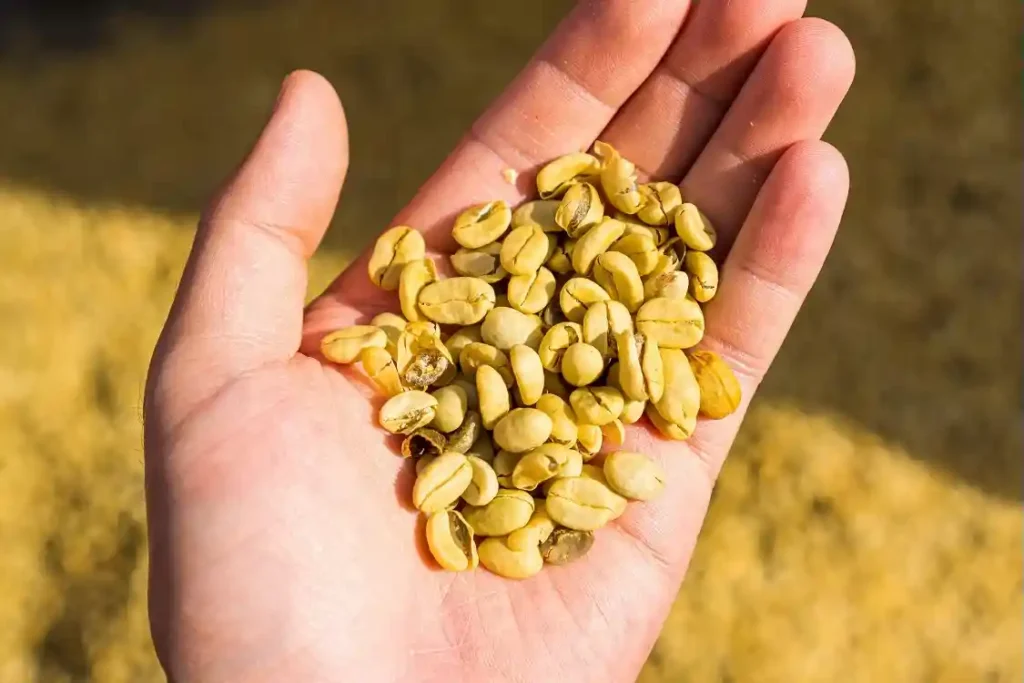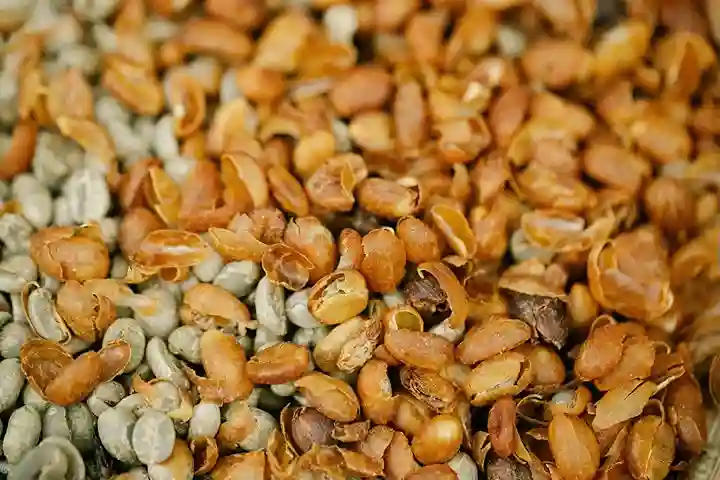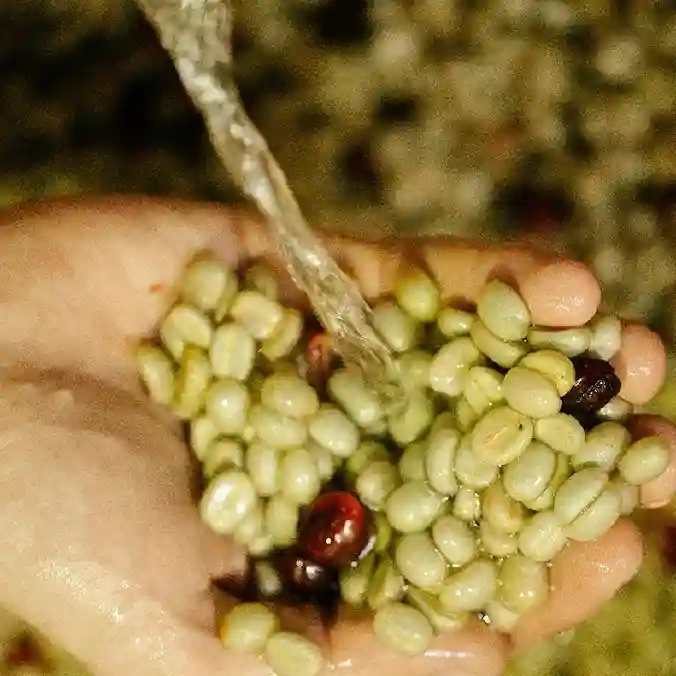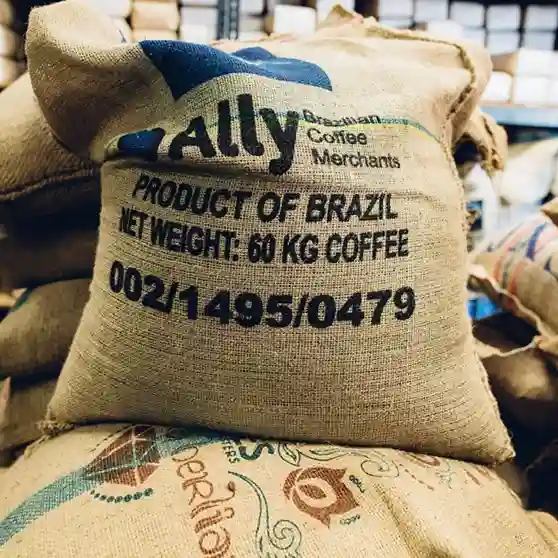Green coffee
Unlike traditional coffee, unprocessed coffee retains a unique set of biologically active substances that form a specific chemical composition. Unroasted coffee beans have a milder, more herbal flavor. Today, it is often seen not only as a raw material for further processing, but also as an independent product popular among healthy lifestyle advocates.
The main components of the chemical composition
The chemical composition of green coffee is extremely rich and diverse. It determines not only the potential benefits for the human body, but also the flavor characteristics of the drink after roasting.
Alkaloids
Green beans contain about 1-2% caffeine. Its amount depends on the variety, growing conditions, and processing. It is a well-known stimulant of the nervous system, the effect of which on the body leads to improved concentration, increased tone, and reduced fatigue.
Trigonelline is a lesser-known alkaloid that is involved in the formation of coffee flavor during roasting. Its role in the prevention of neurodegenerative diseases is currently being actively studied.
The grains also contain other compounds that have a stimulating effect on the cardiovascular system, such as theobromine and theophylline.
Chlorogenic acids
The chemical composition of green coffee is characterized by a high content of chlorogenic acids, up to 12% of the dry weight of the bean. They have antioxidant properties, can slow down the absorption of glucose in the intestines and lower blood sugar levels.
Organic acids
Raw grains contain malic, citric, oxalic and other organic acids. They affect the acidity of the drink and the absorption of minerals in the body. During the roasting process, these acids are partially destroyed or transformed.
Lipids and fats
The fatty component of coffee beans is represented by triglycerides, phospholipids, sterols and other compounds. These components not only affect the stability of the bean during storage, but also shape the texture and fullness of the finished beverage.
Proteins and amino acids
Proteins are another important part of the composition of specialty coffee, especially when it comes to high-quality raw materials. During roasting, proteins enter into the Maillard reaction to form hundreds of aromatic compounds.
Carbohydrates and sugars
The bulk of the mass is made up of carbohydrates: polysaccharides (e.g. cellulose) and simple sugars (sucrose, glucose). The sugar content determines the sweetness of coffee after roasting.
Minerals and trace elements
The chemical composition includes more than 30 micro- and macroelements, including potassium, magnesium, calcium, phosphorus, iron, and zinc. The balance depends on the soil, variety, and growing conditions. These substances are essential for maintaining mineral metabolism in the body.

Physical and chemical characteristics
They determine the quality, storage stability, and behavior of the grain during roasting.
Moisture content
Moisture content is a critical indicator of green coffee quality, usually 10-12%. An excess causes mold or fermentation, while a lack causes loss of flavor and uneven roasting. The optimal level preserves the chemical composition of specialty coffee, which is especially important for producers. Even minor deviations affect the result. This is critical for producers of specialty products.
Gases and aromatic compounds
Raw beans contain a wide range of volatile organic compounds that contribute to the flavor and aroma after roasting. These include terpenes, furan compounds, alcohols, esters, and aldehydes.
The high density of the green coffee structure helps to preserve these substances until the moment of heat treatment. Gases can be formed as a result of microbiological activity or storage conditions, changing the flavor and effect of the finished product on the body.
Factors affecting chemical composition
The chemical composition of specialty coffee or commercial beans is the result of many external and internal factors.
Coffee variety and origin
The variety of coffee tree and terroir significantly change the profile of acids, minerals and aromatic components of the bean. Arabica usually contains less caffeine but has a higher content of chlorogenic acids compared to Robusta. And the chemical composition of specialty coffee from Ethiopia is significantly different from commercial coffee from Brazil. Highland varieties tend to have a more complex flavor profile.
Growing and processing conditions
Climate, precipitation, temperature, and the way the beans are processed all have an impact on coffee beans. The washed processing method allows for more acid retention, while dry processing contributes to body and sweetness, but can increase acid loss during roasting.
Thanks to optimal growing conditions, a stable composition of high-quality coffee can be obtained, which is easy to predict and well preserved at further stages of production.
Storage conditions
After harvesting and drying, coffee becomes extremely sensitive to external factors. Improper storage leads to fat degradation, a decrease in chlorogenic acid content, and loss of volatile compounds.
Specialty coffee vs. commercial coffee
The difference between specialty and commercial coffee is not only in taste or aroma, but also in the chemical composition of the beans that have not been heat-treated. These differences are formed at all stages, from variety selection to storage and transportation.
High-quality specialty coffee beans are grown in unique terroirs under close supervision. These beans are characterized by stability during roasting and have greater potential.
Commercial coffee is harvested on a massive scale without strict quality control, resulting in a decrease in the content of biologically active substances.

Influence of chemical composition on taste
The chemical composition determines the flavor and aroma. Organic and chlorogenic acids are responsible for acidity and bitterness. Sucrose and proteins contribute to the sweetness, spicy notes and body of the beverage through caramelization and Maillard reactions. Fats affect the texture. Caffeine and trigonelline are sources of bitterness; the latter is converted to pyridine, adding coffee flavor. A rich composition is the key to a complex flavor.
Effects on the human body
Research into the effects on the body is ongoing. The effect of unroasted coffee beans is being studied in the fields of medicine, nutrition and sports nutrition. It’s important to keep in mind that the effect depends on the quantity, quality, individual sensitivity, and method of consumption.
Useful properties
Chlorogenic acids neutralize free radicals, reduce inflammation, blood pressure and blood sugar. Caffeine stimulates the nervous system, increases attention and vigor.
Possible risks and limitations
Despite the positive effects, excessive consumption of caffeinated beverages can cause increased anxiety, headaches, and heart rhythm disturbances.
The issue of weight loss
Chlorogenic acids can help lower glucose levels, improve fat metabolism, and reduce intestinal absorption of carbohydrates. However, the effect of green coffee on the body in the context of weight loss without changing the diet and physical activity will be minimal.

Practical recommendations
Since the chemical composition directly affects the quality, taste, and potential benefits of a product, it is important to know how to choose and consume it correctly.
Criteria for choosing high-quality natural grains
When choosing coffee beans, pay attention to the variety and region of origin, processing method, freshness, and appearance (integrity, uniformity). Preference should be given to organic or specialty coffee – this is a guarantee of quality.
Consumption rules
To ensure that green coffee is beneficial and does not harm your health, follow these tips:
- Do not exceed the dosage. 2-3 servings per day are recommended.
- Brew the beans with 80-90 °C water for 10-15 minutes.
- Do not drink coffee drinks on an empty stomach.
- If you have chronic diseases or are pregnant, it is advisable to consult
Conclusions.
The chemical composition of green coffee is the basis of its unique properties that affect both its taste and health benefits. The difference from conventional roasted coffee is the preservation of biologically active substances such as chlorogenic acids, caffeine, organic acids, amino acids, lipids and minerals.
Factors that influence this composition include the variety, growing conditions, processing and storage methods. Especially valuable are unroasted specialty coffee beans, which have a more balanced and richer composition of specialty coffee, providing a mild but effective effect on the body.






